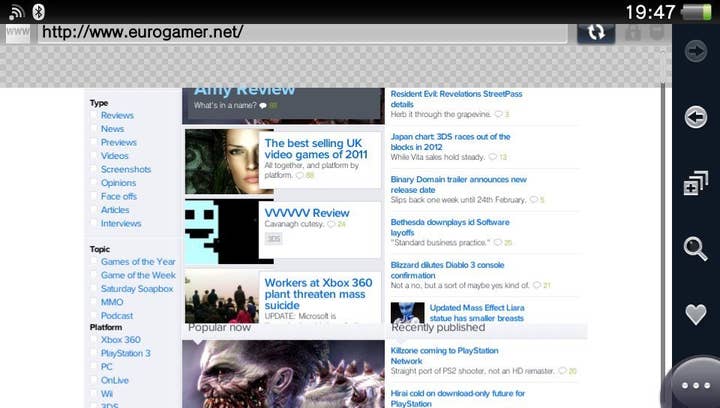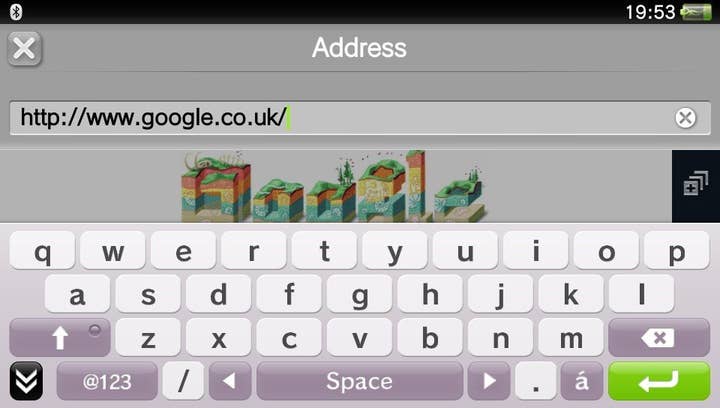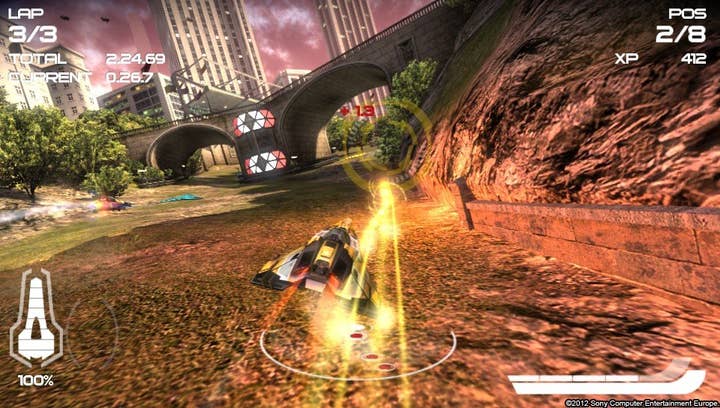Tech Focus: The Power of PlayStation Vita
Digital Foundry on how Sony's new launch eclipses competing mobile platforms
Frustrations? Yes, there are a few - and some might argue that they are rather fundamental for a mobile device aimed at the core, whom many may consider the most demanding of consumers. The notion of social apps that can be multi-tasked alongside gameplay is a great idea, but the fact that the web browser cannot be run simultaneously in this way is a real shame. Similarly, for a mobile device not to have a bespoke email app available from the off is just plain bizarre - especially when a Twitter client is already available to download from PSN.
"To appeal beyond the hardcore, Vita will need to address the issues with its browser and apps, and foster a new environment for cheap, casual gaming."
And then there's quality of the web browser itself. With the Vita's state-of-the-art spec, we should be able to enjoy a browsing experience that's easily on par with the latest iPhone and iPod Touch - in fact it should outstrip these machines. Unfortunately, the reality is that the NetFront software that Sony has chosen for the browser is simply not fit for purpose, slow to work with and possessing some clear compatibility issues. At this point we need to remember that the Vita architecture is essentially double that of the iPad 2 - it's got a quad core processor, remember. Bearing in mind that the hardware comprehensively bests the iOS platforms (for now), it's testament to how poor the browser software is that it should perform so badly.
But for a games machine, do these things matter? While some - including Sony - will be seeing the 3DS as competition, this machine at this price-point is competing for pocket-space not just with the Nintendo handheld, but also with mobile phones and portable media players. It's the biggest challenge yet for Sony in that its competition comes at it from all sides. Vita is undoubtedly a fine machine, but to really make an impact and to appeal beyond the hardcore, it needs to excel in all mobile functions. Hand on heart, right now, I don't think it does that.


There's also the sense that Sony hasn't made life easy for itself with the decisions it has made concerning accessories. Question marks also remain over the bespoke memory cards that Sony has chosen to utilise. Core gamers would more readily accept premium priced products like these if there were a performance benefit but this does not seem to be the case. Right now, a 16GB Vita card costs £40, while a branded Class 10 micro SD card costs around £15 - a phenomenal level of mark-up. These are premium priced products that do not appear to be offering any kind of performance advantage over the standard SD/MicroSD cards. Indeed, based on our initial testing, the speed of these cards actually seems to be rather low - a 10GB sync took about 35 minutes, while loading times on WipEout 2048 are remarkably slow.
Sony has mentioned "security concerns" here - something I would suggest shouldn't be paid for by the user, and also mentions the importance of guaranteed read/write speeds. Performance is certainly important here, particularly when so many games rely upon background streaming in order to overcome memory limitations, but the slow read speeds we've picked up on so far suggest that the Vita format isn't much of a match for the higher class SDHC cards, which are obviously far cheaper. WipEout 2048 is the standout example here, but Uncharted: Golden Abyss is also interesting in that gameplay can be halted by loading - something that doesn't happen on the PS3 games. Comparisons of "cartridge" performance up against the memory card also suggest that there's not a high-speed bus in operation between game and hardware - WipEout only offers nominal speed increases on cart up against running the game from memory card.


These frustrations aside, the weeks I've spent with PlayStation Vita prior to today's launch have been genuinely exciting - the games really are that good. Quirks aside, the hardware is terrific, and it's difficult to imagine a launch line-up that ever matched what this machine offers in terms of both quality and quantity. While legitimate concerns about pricing won't go away, Sony has made some effort in providing value - the notion of cross-format DLC (one purchase across multiple platforms) is great news and the pricing of Sony's own PSN Vita titles ensures that even if gamers can't afford the full price games, there's plenty of top quality downloads available that represent excellent value.
Vita is sure to find a home with the committed gamer, but can it move beyond the traditional core audience? A deeper understanding of what people actually want from a mobile device is required, but much depends on how Sony aims to address the more casual audience. Much was expected from the PlayStation Suite initiative, which aimed to open up Vita and all PlayStation-certified devices (Xperia Play, plus the Sony tablets with more to follow), but thus far all we've seen have been some over-priced, crusty PS1 games. As the platform evolves and becomes cheaper, hopefully Sony's plans for the more casual gaming audience will become clearer.








